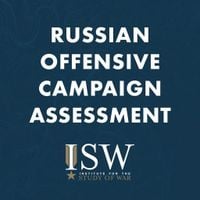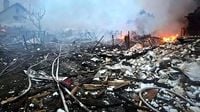The war in Ukraine has entered a new, perilous phase as autumn 2025 arrives, with Russian forces intensifying their push in the eastern Donetsk region and the Kremlin ramping up both military pressure and diplomatic maneuvering. According to the Associated Press, Ukraine’s armed forces are bracing for a tough fall, facing relentless Russian attacks aimed at seizing what remains of Donetsk, a region Moscow has long coveted and now controls about 70% of. Ukrainian defenders have been pushed back to a string of four cities, dubbed the "fortress belt," where they’ve held out for years—but the pressure is mounting like never before.
The situation on the ground is grim. Russian troops are avoiding the kind of costly urban warfare that saw staggering losses in places like Bakhmut and Chasiv Yar. Instead, they’re employing infiltration tactics: small units slip through gaps in Ukrainian lines, sometimes managing to occupy abandoned positions or disrupt supply routes. The cost for these Russian units is steep—Ukrainian commanders estimate that, of every five soldiers sent, two are killed, one is wounded, one goes missing, and only one survives to call for help. Yet these are "tactical successes, not strategic ones," as Colonel Pavlo Yurchuk, whose brigade is defending the northern town of Lyman, explained to the Associated Press. "This tactic is very slow and does not solve the tasks of encirclement or control of large settlements."
Russia’s evolving battlefield strategy also leans heavily on drones and glide bombs, which are used to strike Ukrainian troops and supply lines without direct engagement. This summer, Russian attacks have intensified at both the northern and southern edges of the Donetsk belt, with a clear aim: sever Ukrainian supply lines and surround the fortress cities, rather than storm them head-on. The region, which Russia illegally annexed in 2022, has become the epicenter of fighting since the full-scale invasion began.
In Lyman, a key logistics hub with a prewar population of 20,000, Ukrainian forces are digging in. The town’s rail connections and sturdy infrastructure make it a prize for whoever holds it. If Russia takes Lyman, it could use the town as a staging ground to cross the Siverskyi Donets River and threaten Sloviansk, another major city. Still, Colonel Yurchuk remains skeptical that Russia’s latest offensive will succeed. "From a military point of view, it looks correct—on the map it looks neat—but after nearly three and a half years of war we all know that such deep maneuvers and wide flanking operations are not Russia’s forte," he said. "They simply won’t be able to control and supply those penetrations, so I’m sure that they will fail."
Further south, Russian advances near Pokrovsk have brought them closer to Kostiantynivka, once home to 67,000 people but now largely deserted. The fighting’s outcome is hard to predict—Russian advances could become a full breakthrough, or the battle could drag on for months or even years. What is clear is that Ukraine is struggling with shortages of troops and supplies, compounded by chaotic management and inefficiencies in command and training. According to Taras Chmut, director of the Come Back Alive Foundation—which has raised over $388 million in support of Ukrainian forces—some brigades list thousands of soldiers on paper but can only field hundreds in combat. "It’s a systemic flaw we can neither admit nor fix," Chmut told the Associated Press. "Until we do, we have to make up for it with technology, with manpower, with the enemy’s weaknesses on the battlefield, and with the courage of people and volunteers who step in where they can."
But these measures are only temporary, Chmut warns. Without broader changes—like fixing management failures and acquiring new technology or benefiting from a major geopolitical shift—the outlook for Ukraine is bleak. "The longer this drags on, the worse it will get—and without fresh resources the Russians will simply outmatch us in quantity and means." Nick Reynolds, a fellow at the Royal United Services Institute, echoed these concerns, noting that "the Ukrainian Armed Forces have been under enormous pressure for a very long time." The fall of the fortress belt, he cautioned, would displace thousands and inflict further economic damage, but even then, the war would be far from over. "I see absolutely no reason, no indication why the Russian Federation or the Russian Armed Forces would stop" with Donetsk, Reynolds said.
On the diplomatic front, Russian President Vladimir Putin is playing a dangerous game of nuclear brinkmanship. On September 22, Putin announced that Russia would adhere to the New Strategic Arms Reduction Treaty (New START) for one year after its expiration in February 2026, but only if the United States does the same. New START, which limits deployed US and Russian strategic nuclear warheads to 1,550 and various launchers to 800, has been a cornerstone of nuclear arms control since 2011. However, as reported by the Institute for the Study of War (ISW), Russia suspended its participation in the treaty in February 2023, claiming the US was developing new nuclear weapons.
Putin’s recent statements, laced with threats, are part of a broader campaign to pressure the US—now under President Donald Trump—to engage in arms control talks that could lead to concessions on Ukraine and a normalization of relations. Putin warned that abandoning New START entirely would be a "mistake" and hinted at "military-technical measures" if the US fails to comply. He also accused the West of undermining arms control, while ignoring Russia’s own record of violating numerous treaties, including the Open Skies Treaty, the Conventional Forces in Europe Treaty, and the Chemical Weapons Convention. According to ISW, Russia maintains up to 2,000 non-strategic nuclear weapons and has used banned weapons both on the battlefield and against political opponents.
The Kremlin’s saber-rattling comes as Russia’s own defense industry faces significant challenges. As Novaya Gazeta reported, wages in the Russian defense industrial base have declined for the first time since the full-scale invasion began, and many factories are operating at full capacity with little room to expand. The government is prioritizing funding for high-demand weapons like drones and missiles, while other sectors of the defense industry struggle to keep up. This focus has contributed to broader economic issues, including inflation and supply chain bottlenecks.
Meanwhile, the human toll of the conflict continues to mount. The United Nations reported a 40 percent increase in casualties from Russian drone strikes targeting Ukrainian civilians so far in 2025 compared to the previous year. Russian forces have been accused of deliberately striking civilians, residences, and critical infrastructure, as well as conducting "double tap" strikes against rescue workers. These actions, according to the UN Commission of Inquiry on Ukraine, amount to crimes against humanity and are part of a concerted state policy to sow terror among the Ukrainian population.
Despite these dire circumstances, Ukrainian forces continue to resist. Recent operations have targeted Russian military sites in occupied Crimea, including reported strikes on high-ranking officials and airfields. Yet, as the fighting drags on and both sides adapt their tactics, the prospect of a swift resolution remains elusive. The coming months are likely to bring further hardship for Ukrainian defenders and civilians alike, as well as new challenges for the international community seeking to contain the conflict and prevent its escalation.
For now, the fortress belt holds—but the stakes have never been higher, and the world is watching to see whether Ukraine can withstand the storm or if a new chapter in this grinding war is about to unfold.


